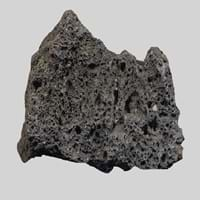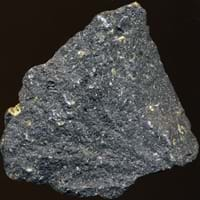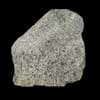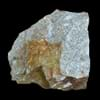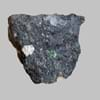Definition
Scoria is a dark-colored extrusive igneous rock with abundant round bubble-like cavities
Basalt is a common extrusive igneous rock formed by the rapid cooling of basaltic lava exposed at or very near the surface of Earth
Discoverer
Unknown
Georgius Agricola
Etymology
From late Middle English (denoting slag from molten metal), from Greek skōria refuse, from skōr dung
From Late Latin Basaltes (variant of basanites ), very hard stone, which was imported from Ancient Greek Basanites
Class
Igneous Rocks
Igneous Rocks
Sub-Class
Durable Rock, Medium Hardness Rock
Durable Rock, Medium Hardness Rock
Other Categories
Fine Grained Rock, Opaque Rock
Fine Grained Rock, Opaque Rock
Texture
Vesicular
Glassy, Massive, Porphyritic, Scoriaceous, Vesicular
Color
Black, Brown, Dark Grey to Black, Red
Black, Brown, Light to Dark Grey
Durability
Durable
Durable
Scratch Resistant
Yes
Yes
Appearance
Glassy and Vesicular
Dull and Soft
Interior Uses
Decorative Aggregates, Interior Decoration
Floor Tiles, Homes, Hotels, Kitchens
Exterior Uses
Garden Decoration, Paving Stone
As Building Stone, Paving Stone, Garden Decoration, Office Buildings
Other Architectural Uses
Curbing
Curbing, Whetstones
Construction Industry
Cement Manufacture, Construction Aggregate, for Road Aggregate, In landscaping and drainage works
Arrowheads, As Dimension Stone, Cobblestones, Cutting Tool, Rail Track Ballast, Roadstone
Medical Industry
Not Yet Used
Not Yet Used
Antiquity Uses
Artifacts, Monuments, Sculpture
Artifacts, Monuments
Commercial Uses
As a traction material on snow-covered roads, Creating Artwork, High-temperature insulation, In gas barbecue grills
An Oil and Gas Reservoir, Commemorative Tablets, Creating Artwork, Used in aquariums
Types
Not Available
Alkaline Basalt, Boninite, High Alumina Basalt, Mid Ocean Ridge Basalt (MORB), Tholeiitic Basalt, Basaltic trachyandesite, Mugearite and Shoshonite
Features
Available in Lots of Colors and Patterns, Generally rough to touch, Surfaces are often shiny
Has High structural resistance against erosion and climate, Very fine grained rock
Archaeological Significance
Famous Monuments
Data Not Available
Easter Island in the Polynesian Triangle, Pacific Ocean, Gateway of India in Mumbai, India, Gol Gumbaz in Karnataka, India
Famous Sculptures
Data Not Available
Data Not Available
Formation
Scoria forms when magma containing huge amount of dissolved gas flows from a volcano during an eruption.
Basalt forms when lava reaches the Earth's surface near an active volcano. The temperature of lava is between 1100 to 1250° C when it gets to the surface.
Mineral Content
Apatite, Biotite, Calcite, Feldspar, Hematite, Hornblade, Ilmenite, Magnetite, Olivine, Pyroxene, Quartz, Silica
Olivine, Plagioclase, Pyroxene
Compound Content
Ca, NaCl
Aluminium Oxide, CaO, Iron(III) Oxide, FeO, Potassium Oxide, MgO, MnO, Sodium Oxide, Phosphorus Pentoxide, Silicon Dioxide, Titanium Dioxide
Types of Metamorphism
Burial Metamorphism, Cataclastic Metamorphism, Contact Metamorphism
Contact Metamorphism
Types of Weathering
Biological Weathering, Chemical Weathering, Mechanical Weathering
Biological Weathering
Types of Erosion
Chemical Erosion, Coastal Erosion, Glacier Erosion
Not Available
Grain Size
Fine Grained
Fine Grained
Fracture
Conchoidal
Conchoidal
Streak
White
White to Grey
Porosity
Highly Porous
Less Porous
Luster
Subvitreous to Dull
Not Available
Compressive Strength
Not Available
Cleavage
Perfect
Not Available
Specific Gravity
Not Available
2.8-3
Transparency
Opaque
Opaque
Density
Not Available
2.9-3.1 g/cm3
Specific Heat Capacity
Not Available
Resistance
Heat Resistant, Impact Resistant, Pressure Resistant, Wear Resistant
Heat Resistant, Pressure Resistant, Wear Resistant
Deposits in Eastern Continents
Asia
Afghanistan, Indonesia, Japan, Russia
India, Russia
Africa
Ethiopia, Kenya, Tanzania
South Africa
Europe
Greece, Hungary, Iceland, Italy, Turkey
Iceland
Others
Not Yet Found
Not Yet Found
Deposits in Western Continents
North America
Bahamas, Barbados, Canada, Costa Rica, Cuba, Jamaica, Mexico, USA
Canada, USA
South America
Argentina, Chile, Ecuador, Peru
Brazil
Deposits in Oceania Continent
Australia
New Zealand, Western Australia
Not Yet Found
All about Scoria and Basalt Properties
Know all about Scoria and Basalt properties here. All properties of rocks are important as they define the type of rock and its application. Scoria and Basalt belong to Igneous Rocks.Texture of Scoria is Vesicular whereas that of Basalt is Glassy, Massive, Porphyritic, Scoriaceous, Vesicular. Scoria appears Glassy and Vesicular and Basalt appears Dull and Soft. The luster of Scoria is subvitreous to dull while that of Basalt is not available. Scoria is available in black, brown, dark grey to black, red colors whereas Basalt is available in black, brown, light to dark grey colors. The commercial uses of Scoria are as a traction material on snow-covered roads, creating artwork, high-temperature insulation, in gas barbecue grills and that of Basalt are an oil and gas reservoir, commemorative tablets, creating artwork, used in aquariums.
